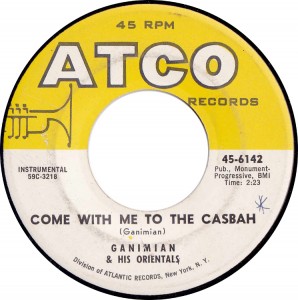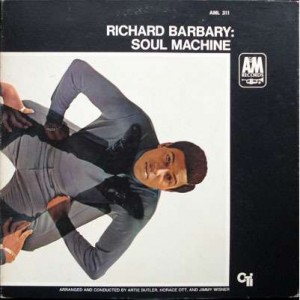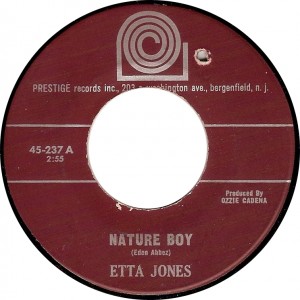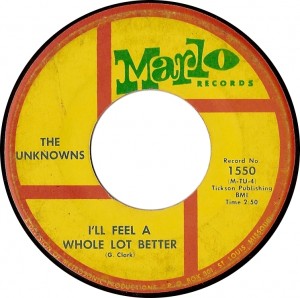The records that capitalized on post-War America’s tastes for Middle Eastern music encompass an absolutely fascinating continuum.
At one end there were the country-by-country ethnic field recordings released by Folkways, Lyrichord, Monitor and other specialist labels, academic packages for armchair anthropologists. At the other extreme was the unreconstructed orchestral exotica of albums like Ron Goodwin’s Music for an Arabian Night, Bob Romeo’s Aphrodisia and Sonny Lester’s How to Belly Dance for Your Husband and a proliferation of novelty “Oriental” rock ‘n’ roll singles like Bill Haley’s “Oriental Rock,” Johnny & the Hurricanes’ “Sheba” and Ralph Marterie’s “Shish Kebab.”
And somewhere between ethnography and exotica lay a substantial subset of secular Arabic music that was very successfully marketed to American audiences. The music originated amongst a set of musicians, generally first- or second-generation immigrants, who played a loose circuit of restaurants, theaters, hotels, night clubs and social functions in the Northeast and Upper Midwest. Though nominally authentic, theirs was a music that was modern enough to appeal to American consumers with a casual interest in Middle Eastern music and rhythms. The albums these groups made, found easily in local record stores, and typically sleeved in colorful covers featuring belly-dancers in kitschy “Casbah” interiors, sold very well, with bigger names like Fred Elias, Gus Vali, Artie Barsamian, Eddie Kochak, Eddie Mekjian, Naif Agby, Mohammed El-Bakkar, George Abdo releasing dozens upon dozens of recordings in their time. The music itself tended to reflect these groups’ diverse repertoire of Armenian, Lebanese, Syrian, Turkish, Greek, Egyptian and Jewish folk songs, ballads and dances.
But there were also the occasional recordings that were a bit stranger, and a bit more difficult to classify. Generally these attempted to mix Arabic and Western forms, taking shape as either curious rock ‘n’ roll hybrids or exotica larks incorporating Latin dance rhythms or elements of American jazz or pop.
Sometimes these experiments worked beautifully, becoming something more than the sum of their parts. Sometimes they just came out strange. Nearly always they were interesting.
This week we look at three of the best.
 1. Eddie Kochak & Hakki Obadia, Jazz in Port Said (Bossa Nova Araby) (Georgette 403)
1. Eddie Kochak & Hakki Obadia, Jazz in Port Said (Bossa Nova Araby) (Georgette 403)
Released in 1962, the spellbinding “Jazz in Port Said” was one of the earliest recorded products of a long-lasting collaboration between percussionist Eddie “The Sheik” Kochak and violinist Hakki Obadia.
Kochak was born Eddie Soubhi Ibn Farjallah Kochakji to Syrian parents in Brooklyn, New York. Drawn to drumming as a child, Kochak would come to be a specialist in the derbeki drum. Hakki Obadia is an Iraqi-born Jew and classically trained multi-instrumentalist who first established a name for himself in the Middle East with concert and radio appearances as a child prodigy violinist.
The two musicians first met in the mid-‘50s. Kochak was then performing and leading groups in various New York and New Jersey-area venues. Obadia was playing around New York City area, where he’d recently settled after pursuing music studies at Berkeley.
First as performers, and later in the recording studio, they would create and promote their “Amerabic” sound – the melodies and rhythms of various Middle Eastern Arab standards and folk songs updated for American audiences.
Their “Jazz in Port Said” was one of the earliest of these recorded collaborations. It was, in terms of its Western jazz sensibilities and moody, propulsive arrangement, also among their most adventurous early recordings.
“Jazz in Port Said” also saw inclusion on their Ameraba: Music with the New Amer-Abic Sound. The album would be among the first in a series of very popular LPs by Obadia and Kochak, along with their frequent partner, the violinist and oud player Fred Elias. Many of these albums were recycled and repackaged throughout the ‘60s and ‘70s with successive waves of interest in belly-dancing, their Strictly Belly Dancing series proving especially popular.
Kochak and Obadia continued to release their “Amerarabic” music over the years. Kochak himself remained one of the bigger names in post-War Arab-American entertainment, and something of a fixture in New York show business. Obadia, who published his Oud Method book in 1969, worked as a music teacher in the public schools of Long Island, and continued to perform and record.
Sources: Katherine Benson & Philip Kayal’s Community of Many Worlds: Arab Americans in New York City, http://www.eddiekochak.net, Phyllis Saretta’s Eddie “The Sheik” Kochak.
 2. The Sheiks, Ya-Habibi (Sultan S-1001)
2. The Sheiks, Ya-Habibi (Sultan S-1001)
“Ya-Habibi” was at least partly the handiwork of New York City-based Frank Cari and his songwriting partner Anna Vito.
As a freelance writing team, Cari and Vito penned a number of songs in the late ‘50s and early ‘60s, largely for the doo-wop and teen pop markets. Their biggest hit, “High on a Hill,” performed by Brooklyn singer Scott English in 1963, was typical of the New York City pop sound that the British Invasion would soon obviate.
In this time Cari also operated both his Turban Music publishing concern and his Frank Cari Productions, which was responsible for a number of pop-oriented 45 releases. And finally there was Sultan Records, which Cari founded in the late ‘50s. Among the 45s released during the label’s brief few years were the Inspirations’ “The Genie,” the Accents’ “Rags to Riches,” and, more interestingly, the Aztecs’ Duane-Eddy-inspired “Aztec Rock” and the Social Outcasts’ “Mad,” a strange instrumental with a wisp of the Middle Eastern aesthetic. (Note the recurring Middle Eastern motifs here.)
But nothing in the Sultan catalog quite matches the electric, booming “Ya-Habibi,” which was among the label’s very first releases, and which is nearly psychedelic in its instrumentation and echo-chamber aesthetic. Its flipside, the slightly-less-unhinged-but-also-great “Sultan’s Delight,” was penned by Jack Ghanaim, a musician whose kanoon playing is heard on jazz bassist Ahmed Abdul-Malik’s groundbreaking 1958 debut Jazz Sahara. Likely released in 1959, its players and backstory remain otherwise maddeningly mysterious, though it seems very likely that it’s Ghanaim heard on the oud on both sides of this 45. Clearly there was more in the way of “authentic” musicianship here than the average Middle Eastern rock ‘n’ roll novelty, either way.
 3. Ganimian & His Orientals, Come With Me to the Casbah (Atco 45-6142)
3. Ganimian & His Orientals, Come With Me to the Casbah (Atco 45-6142)
Oud player Charles “Chick” Ganimian was born in 1926 in upstate New York. Like many of the figures of in post-War Arab-American music, Ganimian grew up in this country; his father, an Armenian immigrant who’d arrived from Turkey, also played oud, and from an early age the younger Ganimian seems to have been fascinated with the music of his heritage.
In the mid-‘30s, the Ganimian family moved to New York City. In the late ‘40s Chick first formed the Nor-Ikes Orchestra, a group largely comprised of Armenian musicians, one of the first to consciously revive the music for mixed audiences, playing various social engagements for the broader Arab-American community.
Well regarded early on as an oud player, Ganimian did not record as prolifically as some of his peers. He was nothing if not bold about exploring different forms, however. A modest (and surprising) pop hit in 1958, his “Daddy Lolo (Oriental Rock ‘n’ Roll”) b/w “Halvah,” was crossover rock ‘n’ roll at its weirdest.
Which brings me to “Come With Me to the Casbah.” Released in 1958, its spoken word bits are straight Orientalist hokum but its fine solos and terrific arrangement still make for a fun experience. The selection would see release on a full-length album, also entitled Come With Me to the Casbah, that was released the same year on Atco Records, sister label to R&B giant Atlantic Records.
That album, recorded over the course of several sessions in 1957 and 1958, is an unusual and fascinating artifact, a mix of a slightly updated dances from the Arabic world, East-West rock ‘n’ roll novelties and fairly faithful readings of American standards performed on regional instruments.
The 1958 session that produced “Come With Me to the Casbah” featured an interesting roster. Not only did Ganimian’s longtime compadres in the Nor-Ikes – Steve Bogoshian (clarinet), Ed Malasian (or Malkasian, percussion), Aram Davidan (dumbek) and Souren “Sudan” Baronian (tenor sax) – participate in the session, but they were joined by Anglo jazz musicians Al Schackman (guitar), Peter Ind (bass), Dick Palazzolo (drums) and Peter Franco (drums).
Ganimian’s overlap with the jazz world is worth noting here. Obsessives might have noticed the Lennie Tristano connections; Peter Ind in particular had a long-running, crucial association with the influential jazz pianist Lennie Tristano, whose “school” was very influential in post-War bebop and cool jazz. Interestingly, both Bogoshian and Baronian had played with Tristano, too, though Bogoshian’s association, which is only alluded to in the liner notes of the Come With Me to the Casbah LP, is unconfirmed by other sources.
Ganimian would continue performing in the ‘60s and ‘70s, making regular appearances and enjoying residencies in New Jersey and New York. His few recorded appearance from included a live date from 1978 (released later), as well as an independently-released 1975 LP with the Nor-Ikes. He would also occasionally appear on other jazz dates; he’s heard in the mid-‘60s on flautist Herbie Mann’s Wailing Dervishes and sublime Impressions of the Middle East albums, and on David Amram’s 1972 Subway Night. Perhaps only fellow oud player John Berberian would enjoy as much overlap with the jazz world in the ‘50s and ‘60s.
Charles “Chick” Ganimian passed away in 1989.








 1.
1. 
























